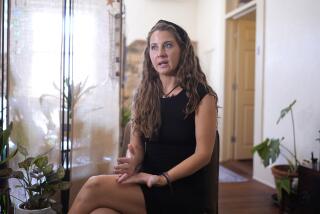Delivery Dads : Fathers take active role in their babies’ birth. Critics say doctors are putting themselves at risk.
- Share via
During the births of his first two children, Craig Mathew was hardly what you would call a non-participating father.
He gripped his wife’s hand and smoothed her brow during labor.
He cheered her on as the doctor eased both babies into the world.
He snipped both umbilical cords.
He photographed the moment his wife first held each child.
But last month, when his wife was wheeled into a Thousand Oaks hospital’s delivery room for the birth of their third child, Mathew had decided to be even more involved in the event.
So this time, he delivered the baby himself.
“It made me feel so much more a part of it,” said Mathew, whose movements were overseen by his wife’s obstetrician. “Mothers get to bond with the baby right away and hold him right after he’s born, but the fathers have to just stand by watching. This gave me the chance to bond not only with my son, but also with my wife.”
Mathew, it appears, isn’t alone. Local obstetricians say an increasing number of fathers in the county have grown tired of standing on the delivery room sidelines and now ask to deliver their babies themselves. And despite medical and legal concerns of physicians critical of the practice--and questions about the possible legal implications for hospitals--many of the fathers are granted their requests.
“Just a few days ago I had two fathers ask about it on the same day,” said Dr. Ned Lindsay, an obstetrician in Simi Valley who said he allows fathers to take over in certain low-risk cases. “I show them where to put their hands, which is how you teach other doctors to deliver. It’s kind of like having a co-pilot.”
Although no statistics are available on the number of obstetricians in the county who allow fathers an active role in the delivery process, a survey of physicians revealed that their number may be growing. Several obstetricians said they now permit it if their hands are guiding the father’s hands the entire time. Others said they feel comfortable enough to stand next to the father and give only verbal instructions.
Dr. Terry Cole, a Ventura obstetrician, estimated that one out of 10 babies in his care is now delivered by the father. “This is just a further extension of the public acceptance of prepared childbirth classes and husbands participating in the birth,” Cole said. “Whenever the fathers ask about it, I say the same thing: ‘As long as your wife is in a low-risk situation in labor, and as long as she doesn’t mind your being at that end of the table.’ ”
Cole and other obstetricians who allow the practice stressed that they are always prepared to take over instantly if anything were to go wrong. And since fathers are only allowed to deliver the child if the mother’s labor is progressing normally, they said, they consider the risks to be minimal.
“It’s not like we’re letting him do a Caesarean or stitch her episiotomy,” Cole said. “The father’s just there to make the catch.”
But the issue, many other physicians argue, isn’t quite that simple. For one, critics say, precious moments could be wasted during the 20% of cases in which problems arise during labor. Moreover, opponents charge that having untrained fathers at the delivery table actually could cause complications.
Among other things, Ventura obstetrician Jeffrey Richardson said, “If they let the baby’s head pop out too quickly, the baby can get bleeding within the brain and the mother also could get a bad tear.”
Other obstetricians cited such potential problems as injury to the child’s neck if too much pressure were applied or if the umbilical cord became wrapped around it, damage to the infant’s shoulder if the child were positioned improperly, and lung problems that could develop if the infant inhaled fluids at birth.
“I went to school for nine years to learn how to do this,” Richardson said. “It’s not always that simple.”
Richardson said he occasionally allows fathers to ease the baby out once the head and shoulders have been delivered, after most problems are apt to take place. But allowing fathers to take over completely, he said, “is like doing your own appendectomy.”
Lindsay, who said he has never had any complications arise because of a father’s participation in a birth, disagreed. “It’s not that hard to do, like brain surgery where a little slip can mean a major problem,” he said. “If you run into a little problem, you just have the father step aside.”
That outlook appears to have worked out for obstetricians at Kennedy Memorial Hospital in New Jersey, where more than 2,000 babies have been delivered by their fathers. So far, according to an account in American Baby magazine, the hospital reports that the practice has resulted in no complications and that all the fathers and babies have come through the experience just fine.
But many obstetricians clearly worry just as much about the issue of liability. Already faced with sky-high malpractice insurance premiums and damage awards that statistically are the highest of any medical specialty, several obstetricians expressed the opinion that allowing dads to deliver is tantamount to inviting financial ruin. If anything went wrong with the delivery, they said, a father certainly wouldn’t sue himself.
“I can’t think of anything that would motivate any sane ob/gyn to do it,” said Dr. Gary Nishida, an Oxnard obstetrician who said he gets requests from fathers but always turns them down. “If there were a problem, the father could come back and say, ‘What did I know? He’s the doctor, and he said it was OK.’ ”
But to some degree, said Dr. Raymond Poliakin, the Thousand Oaks obstetrician who stood beside Mathew as he delivered his son at Los Robles Regional Medical Center last month, there is an assumption by the physician that the father understands the risk and liability involved. “I tell them that if they drop the baby, it’s not my fault,” he said.
Dr. Patrick Diesfeld, an obstetrician with offices in Santa Paula and Ventura who said he consents to guiding fathers’ hands in the delivery room, said he believes that the physician is still ultimately responsible for the outcome.
“Certainly liability is a concern, but in a well-selected case with a mature couple who have done enough prenatal classes together, I’ll allow it. Of course,” he added, “most of the time fathers don’t ask about it. They usually need assistance just standing on their own two feet.”
Worry about malpractice lawsuits--especially if a father were involved in the delivery--isn’t hard to understand. Nationally, 77% of all obstetricians have been sued at least once and 25% have been sued more than three times, according to the American College of Obstetrics and Gynecology in Washington, D.C. A study by the Institute of Medicine, an arm of the National Academy of Sciences, also found that in cases against obstetricians, juries find for the plaintiff twice as often as in cases involving other medical specialties, and awards against obstetricians generally run two to three times higher.
Nishida cited still another factor for obstetricians. In California, he said, the statute of limitations on surgery is three years. For obstetrics, he said, it is 21 years.
“In other words, I could retire tomorrow and be sued 20 years from now,” Nishida said. “We’re already looking at this incredible pressure every time we deliver a baby. Why would anyone would want to take even more of a risk?”
Cole and several other obstetricians answer that they do it because of their commitment to a “family-centered birth process” and their refusal to have their medical practices dictated by the fear of lawsuits. Some fathers obviously want to do it, they say, and they consider it to be safe.
Physicians critical of the practice speculate that there is another reason. “Some doctors are desperate for an extra patient,” said Dr. Ara Poladian, an obstetrician with the American Fertility Medical Center in North Hollywood. “Doctors just starting out, or who aren’t very busy, might just say, ‘Why not? We’ll do it.’ ”
So where do medical organizations such as the California Medical Assn. and the American College of Obstetrics and Gynecology stand on the issue? Right now, it’s too soon to tell.
Kris Calvin, manager of family and community health for the CMA, said she “never heard of anything like this, but it doesn’t sound like the safest way to have a baby.” And the CMA does have a longstanding resolution that “obstetrical care should be provided by personnel who are qualified adequately by virtue of education, training and experience.”
Mort Lebow, a spokesman for the American College of Obstetrics and Gynecology, said he only recently heard about the practice of letting fathers into the delivery act. He said he still isn’t sure what to make of it.
“I don’t know, I guess I just come from a different generation,” Lebow said, recalling how times have changed since his wife gave birth decades ago. “My wife didn’t want me around, and so they sent me home and told me they would call me if anything happened. Then, the SOBs didn’t even call me.”
Hospitals, it seems, also haven’t had enough time to examine the trend. Several administrators said they had not heard of dads delivering, and therefore had no policy about it.
Dr. Ken Fogelberg, chief of obstetrics at Los Robles Regional Medical Center in Thousand Oaks, was surprised to hear that a baby had been delivered by a father at the hospital, but said the decision would probably be left up to the individual practitioner. “Right now,” he said, “it’s not an issue.”
That attitude, said Monty Clark, vice president of the Hospital Council of Southern California’s Ventura office, is shortsighted. “Let’s be realistic,” Clark said. “If something goes wrong, the hospital would always be named in a lawsuit. What happens within the four walls of a hospital is the responsibility of the governing board.”
Fogelberg quickly reassessed his position. “Then it may just have become an issue today,” he said.
For fathers such as Richard Peterson, an art instructor at Ventura College, such medical and legal debates aren’t really a concern. Last month, Peterson took the trend a bit further and delivered his first child, Anna, at home with a midwife looking on.
“I’ll never be able to describe what it was like to have the first person she looked at be me, and the first person who touched her be me. There was just this overwhelming sense of love.
“My dad was in the Korean War, and he didn’t see me until I was a year old. I wanted to be there from the start,” he said. “For me, this was the most exhilarating experience I’ve ever had in my life.”
More to Read
Sign up for Essential California
The most important California stories and recommendations in your inbox every morning.
You may occasionally receive promotional content from the Los Angeles Times.













